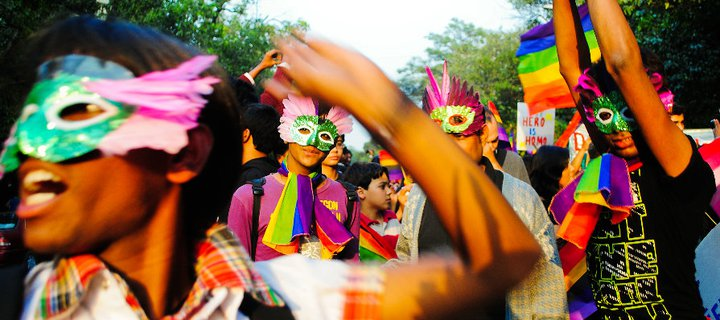In 2013, a two-judge bench of the Supreme Court of India (SCI) handed down a controversial judgment, Koushal v NAZ Foundation upholding the constitutionality of section 377 of the Indian Penal Code, which made it a crime to voluntarily have ‘carnal intercourse against the order of nature’. The Delhi High Court had earlier found the section to be unconstitutional insofar as it ‘criminalises consensual sexual acts of adults in private’. Section 377 was ultimately read down in 2018 by a 5-judge bench of the SCI in Navtez Singh Johar v Union of India, finally decriminalising consensual sexual activity between adults in India. On 17 October 2023, the SCI delivered its highly anticipated judgment in Supriyo v Union of India, declining to legalise same-sex marriage. These cases raise a number of interesting questions about constitutional legacies and emancipation in comparative perspective, the theme of the BACL annual seminar held in June 2023.
In overturning the Delhi High Court decision, Justice Singhvi in Koushal v NAZ Foundation was critical of the High Court’s reliance on comparative jurisprudence. He cited, with approval, earlier SCI judgments that cautioned against attempts to transplant Western experience into Indian jurisprudence and noted, more generally, that the laws of other jurisdictions should be approached with a critical eye, taking account of local context. As a statement of how to approach comparative law in constitutional adjudication, the SCI’s concern about legal transplants is both valid and uncontroversial. However, the sources referenced by the High Court were not exclusively Western. They included key Constitutional Court decisions and academic commentary from South Africa. Second, as has been pointed out by Abeyratne and Sinha, rather than simply adopting the approach of other jurisdictions, the High Court judgment engaged in a dialogue with a ‘range of comparative materials to reflect on the values and assumptions underlying the Indian Constitution.’ This is reflective of the approach of the South African Constitutional Court (SACC) as well. It has drawn guidance from a range of jurisdictions – including India – in its judgments, whilst being cognisant of local context. South African jurisprudence and academic commentary was, again, examined at length in Navtez Singh Johar v Union of India. Whilst the SCI in Navtez was alive to the particularities of the Indian context, the impetus for its reference to South Africa, as a valuable comparative study, lay in a common understanding of transformative constitutionalism and its importance in the constitutional histories of both these countries.

As with many other African and Asian countries, anti-homosexuality laws in India and South Africa are rooted in colonial statutes. There is, thus, an irony in Justice Singhvi expressing concern that Western ideas or sexual mores should not be transplanted into the Indian context whilst, at the same time, upholding a section of the Penal Code firmly derived from British colonial law. In the pre-democratic era, discrimination on the basis of sexual orientation and identity in South Africa was entrenched in, and facilitated by, the country’s various legal traditions – British common law, Roman-Dutch law and, as Christiansen puts it, ‘the heavily Christian-influenced apartheid policies of the National Party’. In NAZ Foundation, the Delhi High Court questioned why a piece of colonial legislation, no longer applicable in Britain itself, should still be in force in India. The history of anti-homosexuality laws in both countries chimes with analyses, such as that by Eric Heinze, demonstrating that the classification of homosexuality as ‘un-African’ or ‘un-Asian’ in a number of postcolonial states is a politically expedient idea that relies for its authority on European colonial statutes, rather than anything that can sensibly be identified as a traditional African or Asian value.
Despite this history of legally-sanctioned prejudice, South Africa became the first country to explicitly prohibit discrimination on the basis of sexual orientation when its 1996 Constitution came into effect. By the time judgment was handed down in the Fourie case, dealing with same-sex marriage, in 2005, the SACC had already overturned the common law prohibition of sodomy, extended benefits for ‘spouses’ of SA citizens under the Aliens Control Act of 1991 to permanent same sex life partners, and found legislation allowing only married couples to adopt a child to be unconstitutional. In Fourie, the Court was unanimous on all issues other than the remedy, with a majority preferring to suspend the order of constitutional invalidity to allow the legislature a period of 12 months in which to remedy the discriminatory legislation. In her partially dissenting judgment, Justice O’Regan preferred a remedy that would allow gay and lesbian couples to be married by civil marriage officers (and religious marriage officers who did not object on religious grounds) with immediate effect.
The disagreement over remedies may appear to be relatively minor, especially for those jurisdictions in which same-sex marriage remains only aspirational, but it raised complex issues about democratic legitimacy, institutional security and public opinion in South Africa. The inclusion of sexual orientation as a listed ground in the equality provision was not a political ‘hot potato’ in South Africa’s constitutional drafting process, but this was because the negotiating parties had other priorities, and not out of a groundswell of support for LGBTQ+ rights. It was well-known that the ruling African National Congress was divided on the matter, and most South Africans were not in favour of gay and lesbian equality. As Theunis Roux has noted, without the support of public opinion behind the issue, the SACC had to tread carefully.
We see some of these concerns echoed in the SCI’s Supriyo decision. The 5-judge bench offered 4 separate opinions on the matter. The judges were unanimous in finding that there was no legally enforceable right to marry and that gender-neutral language could not be read into the Special Marriages Act (SMA). In a wide-ranging minority judgment, Chief Justice Chandrachud, with Justice Kaul concurring, found that the prohibition of discrimination gave rise to an obligation on the state to give legal recognition to unions of queer couples, with ‘queer’ being used as an ‘umbrella’ expression ‘to capture the various sexual orientations and gender identities that exist’. The judges noted the Government’s assurance that it would set up a Committee to define the ‘scope of the entitlements of queer couples who are in unions’ and put in place some guidelines as to what the Committee should address.
For a majority of the judges, even this went too far. Whilst recognising that not having access to the benefits that arise from legal recognition of a union may have a discriminatory impact on queer couples and noting that this was something the government needed to address, Justices Bhat, Kohli and Narasimha found that it was not for the Court to issue any directions with respect to how this was achieved. For the claimants, and other couples in a similar position, there may be some consolation in the judges’ acknowledgement of historical injustice against, and ongoing marginalisation of, the LGBTQ+ community. However, this is small comfort when none of the judges was prepared to declare the current approach to same-sex unions to be unconstitutional.
The judges were not averse to considering the approach in other jurisdictions, as long as the particularities of the Indian context were given sufficient weight. In the lengthiest exploration of comparative law, Chief Justice Chandrachud referred to the SACC’s decision in Fourie. He noted that, by the time Fourie came to be decided, there were already several pieces of legislation that gave some legal recognition to same-sex unions in South Africa. This was not the case in India. Although Chief Justice Chandrachud’s judgment mentions the transformative potential of law, this was a reference to the state’s regulation of marriage having the capacity to amplify ‘equality in the personal sphere and in family life’ and not a comment on the role of the courts.
Like South Africa’s, and despite being enacted many decades before, the Indian Constitution may also be described as transformative, that is, to draw from Karl Klare’s influential 1998 article, ‘an enterprise of inducing large-scale social change through nonviolent political processes grounded in law.’ The fact that the Indian Constitution owed a number of its provisions to a piece of colonial legislation, the 1935 Government of India Act, may appear to undermine its status as a transformative document. However, as Gautam Bhatia has argued, the Constitution was transformative in the sense that it signalled a radical shift in the relationship between the individual and the state through the introduction of universal adult suffrage, and the protection of fundamental rights, including the protection against both public and private discrimination in Article 15.
There is some disillusion with the idea of transformative constitutionalism in South Africa, perhaps most often articulated with respect to the failure of justiciable economic and social rights to have a meaningful impact on deep-seated inequalities. Commentators have been critical of the continuing purchase of a historically formalist legal culture, and, as explored by Sanele Sibanda, the constraints of a liberal democratic paradigm. In the context of same-sex marriage, the SACC had to negotiate the paradox between the explicit prohibition of sexual orientation discrimination in the Constitution, on the one hand, and hostile public attitudes as well as divided opinions within the ruling party itself, on the other.
South Africa’s Janus-faced approach to matters of sexual orientation was reflected, more recently, in its abstention from the Human Rights Council (HRC) vote to mandate the appointment of an independent expert on the subject in 2016. Despite having been the co-sponsor of a 2011 HRC Resolution intended to open a dialogue about human rights, sexual orientation and gender identity, in 2016 South African joined the African bloc of countries in questioning the basis for the mandate, arguing that concepts such as sexual orientation and gender identity are ‘non-internationally agreed notions’ and that these matters should remain within the domestic jurisdiction of states. Again, this surprising shift may be attributed to the political constraints at play – this time, as Nepaul suggests, a desire to appease the country’s regional allies.
In 2019, Michaela Hailbronner noted that ‘transformative constitutionalism is increasingly presented as a new, distinctively Southern paradigm of constitutionalism’. The idea continues to exert an influence in constitutional scholarship and, sometimes, adjudication. Chief Justice Chandrachud’s discussion of Fourie focused on the legislative differences between the jurisdictions, rather than on the shared ideology of transformative constitutionalism. Given that the Court is known for exercising wide remedial powers, it is a pity that it was not prepared to craft a remedy that found the SMA to be unconstitutional, whilst leaving it to government to determine how to rectify the infringement. On this occasion, the political complexities of the matter led the Court to adopt a narrow understanding of its institutional mandate. As noted earlier, there are examples of how the ideals of transformative constitutionalism have failed to transcend the political realities in South Africa. The SCI’s judgment in Supriyo falls into this category as well. However, it is hoped that the minority judgment’s careful debunking of the idea of queer identity as something foreign, urban and elite, its analysis of the discrimination faced by members of the queer community, its acknowledgement that government has a duty to recognise same-sex unions and its pronouncements on the scope of the work of the Committee being set up by government will provide some fuel for the ongoing struggle for LGBTQ+ rights in India.
Posted by Anashri Pillay, Durham Law School.
Anashri Pillay gave a presentation on this topic at the Annual Seminar of the British Association of Comparative Law on 27 June 2023.
Suggested citation: A Pillay, ‘The Promise and Paradoxes of Transformative Constitutionalism: Protection of LGBTQ+ Rights in India and South Africa’, BACL Blog, available at https://british-association-comparative-law.org/2023/11/24/the-promise-and-paradoxes-of-transformative-constitutionalism-protection-of-lgbtq-rights-in-india-and-south-africa-by-anashri-pillay/

